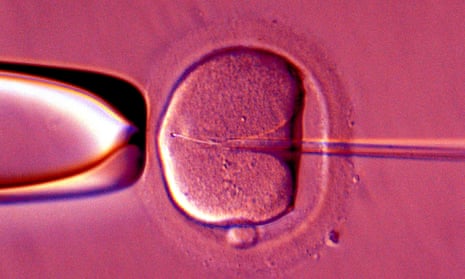Thousands of infertile couples could benefit from a new test that tailors the timing of IVF treatment to a woman’s individual cycle for the first time.
The scientists behind the technique believe that IVF frequently fails because the embryo is transferred at the wrong time, missing a crucial fertility window.
The new test assesses the activity of genes of the womb lining to pinpoint a woman’s optimum time for treatment and in pilot studies the personalised approach appeared to significantly boost success rates.
Prof Juan Garcia-Velasco, of the IVI fertility clinic in Madrid, said: “We think that about 15% of cases of implantation failure are simply due to bad timing.” Prof Garcia-Velasco is now leading a clinical trial of the test, involving 2,500 patients in more than ten countries, including Britain.
Geeta Nargund, medical director of Create Fertility whose London clinic is participating, said: “The weakest link in IVF is implantation failure. I believe this is a breakthrough.”
There are more than 60,000 IVF cycles in Britain each year, but just 24% of these treatments lead to live births. Clinics currently check the visual appearance of the womb lining using ultrasound, giving a general indication of health.
“What we have never known is the right window of implantation,” said Nargund. “If you miss that window, no matter how beautiful the embryo, it’s not going to implant.”
For most women there is a two to four day stretch when the lining, or endometrium, sends out crucial chemical signals that allow the embryo to attach. For some women the fertile window is shifted earlier or later in the cycle or is unusually brief, however.
In the new test, a biopsy of the endometrium is taken and the gene activity is analysed. As the cells enter the receptive phase a series of genes switch on and off in a reliable sequence that scientists can read like a clock.
“I think it will make a significant difference in the expectations of couples and how we can explain failures,” said Garcia-Velasco. “Until now, the endometrium was kind of a black box. Now we can say this was the problem and this is what we can do about it.”
In a pilot study, the test was given to 85 women who had each experienced on average five rounds of IVF that had failed at the implantation stage. In these women, the fertile window was more likely to be shifted early or late, in some cases completely missing the day when the embryo is transferred in standard IVF protocols, the study found.
When the gene analysis was used as a guide, 33% of those treated had a successful implantation – considerably higher than would typically be seen for such a group, Garcia-Velasco said. “This is probably the most difficult population in IVF. Some of them benefit just by changing the day,” he said.
In the international trial, the test will be offered to women who have had two or more previous instances of implantation failure.
Nick Macklon, professor of obstetrics and gynaecology at the University of Southampton, estimates that issues linked to the womb lining explain around two-thirds of cases of recurrent implantation failure, with around one-third of cases being due to embryo abnormalities.
“We really need these tests to better diagnose why a cycle hasn’t worked,” he said. “That’s something that frustrates doctors and patients alike. We know embryos can be perfect and still they don’t implant.”
He believes that the failure to address issues linked to the womb lining explains why IVF success rates have plateaued in the past decade.
“Doing these tests could significantly improve success rates,” he said.
Ultimately, the IVI team are aiming to develop a less invasive version of the test, based on sampling endometrial fluid, that could be used at the time of treatment. The current assessment is done at least one month before the embryo transfer because the act of disturbing the womb lining itself interferes with implantation.

Comments (…)
Sign in or create your Guardian account to join the discussion